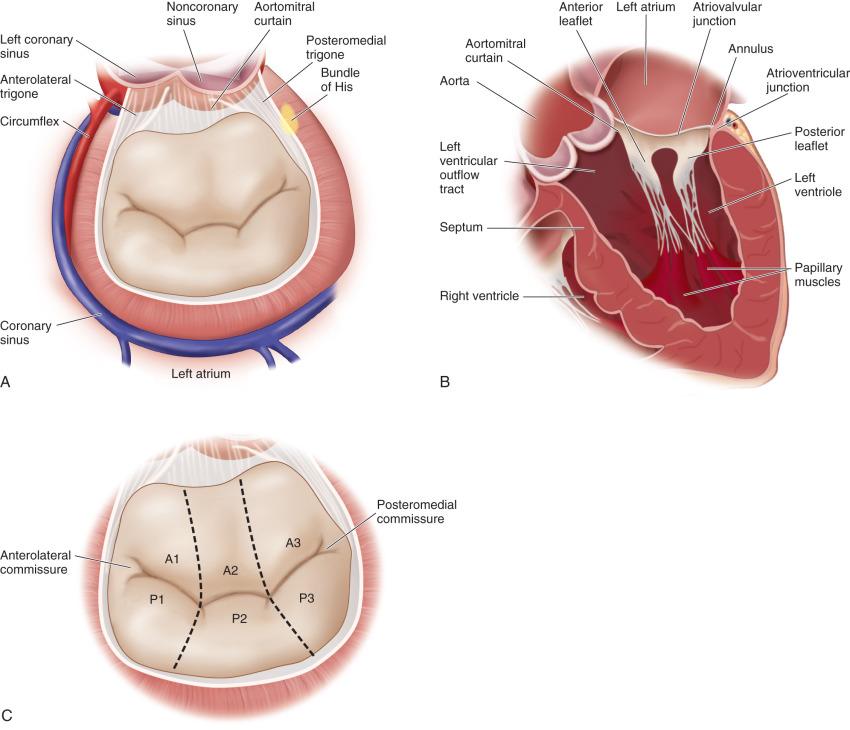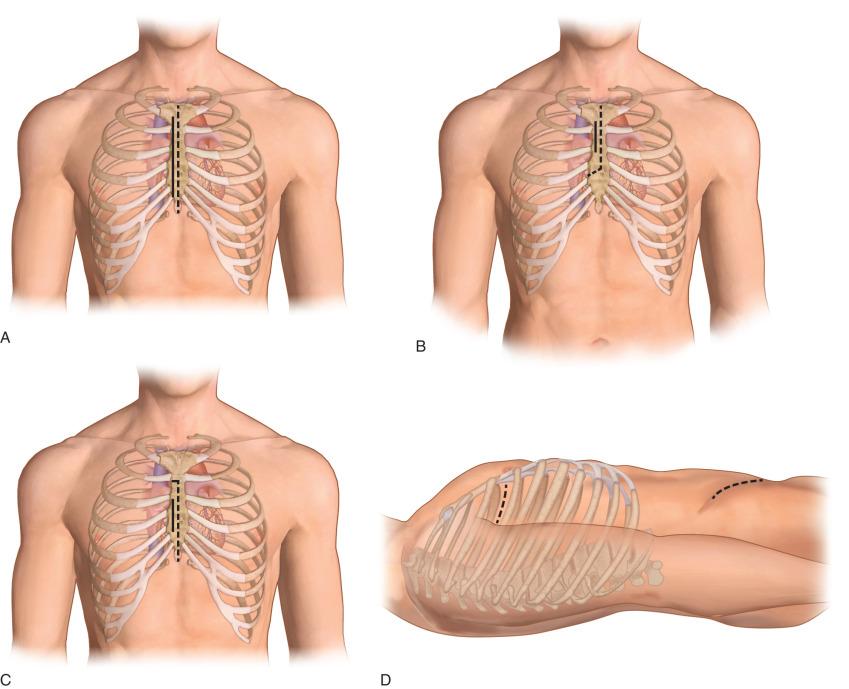Physical Address
304 North Cardinal St.
Dorchester Center, MA 02124
Degenerative mitral valve disease, also called mitral valve prolapse or floppy mitral valve syndrome , is caused by myxomatous degeneration of the mitral valve tissue, whereby elastin and collagen bundles are disrupted, and proteoglycan deposition in the spongiosa results in leaflet thickening and redundancy. This, in turn, can cause impaired leaflet coaptation, chordal elongation or rupture, and annular dilation, resulting in mitral regurgitation.
In the United States and other western countries, degenerative mitral valve disease is the most common cause of mitral regurgitation, with between 2% and 3% of adults suffering from at least moderate mitral regurgitation. Of these, approximately 10% develop significant mitral regurgitation requiring surgical intervention.
Mitral valve repair is the recommended treatment for degenerative mitral valve disease. Mitral valve repair, when compared to replacement, reproducibly improves survival, left ventricular function, and freedom from reoperation.
Despite the superiority of mitral valve repair over replacement, a large proportion of patients with degenerative mitral valve disease still undergo replacement. With experience, nearly any myxomatous mitral valve can be repaired, importantly with near 0% mortality rates.
In this chapter, various techniques for repairing degenerative mitral valve disease are presented. The goal is to provide surgeons with an expanded armamentarium for repairing the mitral valve.
The mitral valve, or left atrioventricular valve, is a dynamic and complex anatomic structure with a three-dimensional saddle shape that changes throughout the cardiac cycle. To perform mitral valve repair successfully, a comprehensive understanding of mitral valvular spatial geometry is compulsory. The mitral valve and its functional components make up the mitral valve apparatus, consisting of the atriovalvular junction and underlying annulus, the anterior (aortic) and posterior (mural) leaflets, and the subvalvular apparatus ( Fig. 18.1A ). The subvalvular apparatus consists of the chordae tendineae, along with their corresponding papillary muscles and underlying left ventricular wall.

The atriovalvular junction (not to be confused with the atrioventricular junction) is the hinge connecting the atrium to the mitral leaflets; it can be easily identified by looking for the demarcation between the pink atrial myocardium and pale leaflets. Approximately 1 to 2 mm deep and external to the hinge is the mitral annulus, which is an ovoid ring of connective tissue anchoring the mitral leaflets to the fibrous skeleton of the heart. It also forms the atrioventricular junction between the left atrium and left ventricle (see Fig. 18.1B ). It is important to note that only the hinge is visible to the surgeon; the deeper annulus cannot be seen. This relationship must be taken into consideration when placing annuloplasty sutures so as not to disrupt the hinge, which may impair leaflet motion.
The annulus is often thought of as fixed, homogenous, and continuous; however, its consistency varies around the circumference of the mitral orifice, and its shape changes throughout the cardiac cycle. Overall, the annulus has a hyperbolic paraboloid (saddle) shape, with the midanterior and midposterior annular segments highest (farthest) from the apex and the anterolateral and posteromedial commissures (PC) at the lowest points.
The mitral valve annulus is connected to the aortic valve annulus at an angle of 120 degrees via the aortomitral curtain. The aortomitral curtain is flanked by the anterolateral (left) fibrous trigone and posteromedial (right) fibrous trigone, which along with the aortomitral curtain make up a particularly dense portion of the annulus where the anterior leaflet of the mitral valve attaches. This constitutes approximately 40% of the circumference of the annulus. The remaining 60% of the annulus suspends the posterior leaflet; this portion of the annulus is discontinuous and thinner, making it more prone to dilation.
The mitral valve is naturally bicuspid, with a larger, semicircular anterior (aortic) leaflet and a smaller, quadrangular posterior (mural) leaflet (see Fig. 18.1C ).
The anterior leaflet delineates the left ventricular inflow tract from the outflow tract. The anterior leaflet free edge is convex and without scallops.
The posterior leaflet usually contains three distinct scallops—the anterolateral scallop (P1), the middle scallop (P2), and the posteromedial scallop (P3). The opposing portions of the anterior leaflet are termed the anterior segment (A1), the middle segment (A2), and the posterior segment (A3). The areas joining the anterior and posterior leaflets are the anterolateral commissure (AC) and the PC. This nomenclature facilitates descriptive noninvasive and surgical valve analysis.
The atrial surface of each leaflet is separated by two visible zones, the more proximal atrial zone, which is smooth and somewhat transparent, and the distal rough zone (also known as the zone of coaptation ). The rough zone is the point at which the leaflets meet during systole. Most chordae tendineae insertion sites are located in the rough zone, giving this region a coarse and irregular appearance (hence, its namesake).
The subvalvular apparatus consists of the chordae tendineae, the anterolateral papillary muscle, the posteromedial papillary muscle, and the free wall of the left ventricle. The subvalvular apparatus helps maintain valve function and integrity throughout the cardiac cycle. During diastole, as blood enters and the left ventricle distends, the papillary muscles and chordae pull the mitral leaflets open, allowing for maximal valve opening and efficient filling. During systole, the papillary muscles contract and shorten, maintaining optimal leaflet height and thereby ensuring a proper zone of coaptation at the level of the annulus to prevent leaflet prolapse.
Chordae tendineae connect the papillary muscle heads (or, in some cases, the ventricular wall) to the leaflets; they are divided into three groups—primary, secondary, and tertiary. Primary (marginal) chordae tendineae attach the papillary muscle heads to the leaflet margin; they are the thinnest of the chordae and serve to prevent leaflet prolapse. Secondary (intermediary) chordae attach the papillary muscle heads to the midsection of the ventricular surface of the leaflets; they are thicker than primary chordae and provide support to the leaflet tissue. Tertiary (basal) chordae are the thickest of the chordae types and connect the base of the leaflet or annulus to the papillary muscle head or ventricular wall; they are typically only found on the posterior and commissural leaflets.
Arising between the middle and apical thirds of the left ventricle, two papillary muscles support the mitral valve, the anterolateral papillary muscle, and the posteromedial papillary muscle. Each papillary muscle supplies chordae to both anterior and posterior leaflets. The papillary muscles and their supporting left ventricular myocardium are critically important in maintaining optimal valvular function, as described previously. The anterolateral papillary muscle is typically solitary and receives blood from the left anterior descending artery and often a branch of the circumflex artery. The posteromedial papillary muscle usually has multiple heads and typically has a solitary blood source from either the circumflex artery or right coronary artery. Because of these anatomic differences, the posteromedial papillary muscle is more sensitive to ischemia and can rupture following a posterior myocardial infarction, leading to acute mitral regurgitation.
Degenerative mitral valve disease represents a spectrum ranging from fibroelastic deficiency, with limited elongated or ruptured chordae, to the Barlow syndrome, with extensive change, including redundant and billowing leaflets. The clinical presentation of patients with fibroelastic deficiency and Barlow syndrome is often unique. Patients with fibroelastic deficiency are often older and tend to have a relatively recent diagnosis of mitral disease without a history of a murmur. The leaflets are thin, and typically only one segment is prolapsed secondary to ruptured chords. On the other hand, patients with Barlow syndrome tend to be younger and have a long history of a murmur; these patients may have a family history of mitral valve disease, as well as marfanoid features. The leaflets are thickened and billowing, often with several prolapsing segments; calcification can be extensive, and atrialization of leaflets may be noted. Mitral regurgitation is also classified as acute or chronic and further subclassified into chronic and compensated or chronic and decompensated. Consideration of cause and chronicity are important preoperative considerations that affect operative planning and risk stratification.
Echocardiography is essential prior to any planned mitral valve surgery because it provides important information about valve anatomy, disease lesions, and underlying cause. Three-dimensional echocardiography can also be a helpful adjunct in planning the repair prior to surgery. Additionally, echocardiography helps interrogate the other heart valves, biventricular function, atrial size, and estimates pulmonary artery systolic pressure.
The mitral valve is conventionally accessed through a median sternotomy ( Fig. 18.2A ). The median sternotomy provides excellent exposure to all structures of the heart and is favored for patients in whom multiple valves or concomitant surgeries (e.g., coronary bypass, aortic valve replacement) are planned with mitral valve repair. In this approach, standard central aortic and bicaval cannulation are preferred. Exposure of the mitral valve can be accomplished through several alternative approaches, as discussed in detail in the following.

A partial upper or lower sternotomy, or hemisternotomy, also permits access to the mitral valve ( Fig. 18.2B, C ). Whereas the lower hemisternotomy reduces the size of the skin incision and extent of sternal separation, the xiphisternal fascia must still be incised and is the area most prone to wound infection.
Our preferred minimally invasive approach is via a right anterolateral minithoracotomy (see Fig. 18.2D, E ). This approach provides an excellent en face view of the mitral valve and spares dissection of the xiphisternal fascia. In patients who have undergone prior cardiac surgery, particularly aortic valve replacement, this minimally invasive approach can be particularly useful in not only avoiding a redo sternotomy, but also in visualizing the mitral valve when a previously placed aortic valve prosthesis prevents excessive manipulation of tissue.
The patient is placed supine on the operating table, with an inflatable cushion placed under the right shoulder to elevate the right chest and rotate the patient slightly to the left. A 3- to 4-cm skin incision is made just above the nipple in male patients and in the inframammary crease in females. The thoracic cavity is entered through the third or fourth interspace. Additional small incisions facilitate placement of an endoscope, suction ports, working arm ports (for robotic surgery), and aortic cross-clamp. Retraction sutures can also be passed through tiny skin incisions using a suture passer, which creates a low-profile and clutter-free operative field.
When using a right anterolateral minithoracotomy, we typically cannulate peripherally. The femoral artery and vein are cannulated via a small groin incision; the internal jugular vein is cannulated percutaneously with a 16 F cannula. Venous cannulae are positioned within the superior vena cava and inferior vena cava under echocardiographic guidance.
We routinely use a transthoracic Chitwood clamp to cross-clamp the ascending aorta. An endoaortic occlusion balloon can also be used, although a significant learning curve exists during which the risk for aortic dissection and stroke are elevated. Finally, fibrillatory arrest strategies may be used in certain situations.
Become a Clinical Tree membership for Full access and enjoy Unlimited articles
If you are a member. Log in here